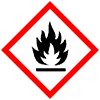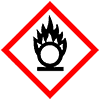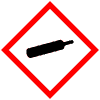What is an SDS, What is a GHS Label, and How to Read and Understand H-Codes, P-Codes, and Pictograms
A Safety Data Sheet (SDS) is a document created by the manufacturer or supplier of a chemical or chemical product that primarily describes the hazards, handling, storage, disposal and emergency response to a spill or accident. All chemical suppliers are required to follow a consistent format when creating SDSs in a 16-section format, but not all SDS will contain information in all 16 sections.
A GHS Label Contains the Following Information:
- Product Identification, product supplier information including address and phone number, and product ingredient information.
- A Signal Word, which is either DANGER or WARNING. By definition, a chemical marked with the DANGER word is more hazardous than one marked with the WARNING word, but that is not to assume that the latter must not be handled with care.
- One or more pictograms that describe the hazard or hazards associated with this chemical. There are only nine symbols that are included in GHS, and though some of them are clear and intuitive, not all are. Below are the ten pictograms with a simplified explanation of what they mean and a hazard statement example:
GHS Hazard Pictogram Hazard Class & Hazard Category Explosive 
- Unstable Explosives
- Explosives, Divisions 1.1, 1.2, 1.3, 1.4
- Self-reactive Substances and Mixtures, Types A, B
- Organic peroxides, types A, B
Flammable 
- Flammable gases, category 1
- Flammable aerosols, categories 1, 2
- Flammable liquids, categories 1, 2, 3
- Flammable solids, categories 1, 2
- Self-reactive substances and mixtures, types B, C, D, E, F
- Pyrophoric liquids, category 1
- Pyrophoric solids, category 1
- Self-heating substances and mixtures, categories 1, 2
- Substances and mixtures, which in contact with water, emit flammable gases, categories 1, 2, 3
- Organic peroxides, types B, C, D, E, F
Oxidizing 
- Oxidizing Gases, Category 1
- Oxidizing Liquids, Categories 1, 2, 3
- Oxidizing Solids, Categories 1, 2, 3
Compressed Gas 
- Compressed Gases
- Liquefied Gases
- Refrigerated Liquefied Gases
- Dissolved Gases
Corrosive 
- Corrosive to Metals, Category 1
Toxic 
- Acute Toxicity (oral, dermal, inhalation), Categories 1, 2, 3
Corrosive 
- Skin Corrosion, Categories 1A, 1B, 1C
- Serious Eye Damage, Category 1
Irritant 
- Acute Toxicity (oral, dermal, inhalation), Category 4
- Skin Irritation, Categories 2, 3
- Eye Irritation, Category 2A
- Skin Sensitization, Category 1
- Specific Target Organ Toxicity Following Single Exposure, Category 3
- Respiratory Tract Irritation
- Narcotic Effects
Health Hazard 
- Respiratory Sensitization, Category 1
- Germ Cell Mutagenicity, Categories 1A, 1B, 2
- Carcinogenicity, Categories 1A, 1B, 2
- Reproductive toxicity, categories 1A, 1B, 2
- Specific Target Organ Toxicity Following Single Exposure, Categories 1, 2
- Specific Target Organ Toxicity Following Repeated Exposure, Categories 1, 2
- Aspiration Hazard, Categories 1, 2
Environ-
mentally
Damaging
- Acute hazards to the aquatic environment, category 1
- Chronic hazards to the aquatic environment, categories 1, 2
- GHS H (Hazard) Codes and Descriptions. These describe the Hazards associated with the chemical. These statements are chosen from a list of approved H Codes in the GHS program to provide consistency in every industry, country and language. There are 72 individual hazard statements and 17 combined hazard statements.
- GHS P (Precautionary) Codes and Descriptions. These describe recommended measures that should be taken to minimize or prevent adverse effects resulting from exposure to a hazardous chemical or improper storage or handling. These statements are chosen from a list of approved P Codes in the GHS program to provide consistency in every industry, country and language. There are 116 individual and 33 combined precautionary statements.
How to Search for and View a Safety Data Sheet and GHS Label
Chemical Safety Software provides a repository of SDS documents and GHS labels which can be accessed at no cost https://sds.chemicalsafety.com/. This database is being updated constantly with new SDS and GHS labeling information.
Once you open the website, multiple search criteria options are available:

You can enter any combination of criteria by typing them in the different fields. You can also select data from the table fields associated with several of the search criteria. You can change the search options to meet your search requirements. The options you have for the Search fields are listed below:

Select one of the Products from the list (for example METHANOL) and the click the Search button, click on the SDS button. In the new pop up window click View MSDS/SDS, the electronic SDS will be displayed. Scroll down to review the entire document, or right-click to print it


To see a label, click on the (M)SDS button, then click View Label/Hazard/PPE Data


